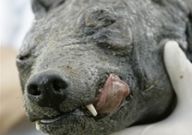But for Phylis Canion, it's a search for the lineage of a beast living under the oak trees of her Cuero ranch.
"The interest in the chupacabra has been overwhelming," said the Cuero rancher.
At least, that's the name the strange creature has been given in the last year.
Its DNA has been flown across the continent as Cuero residents search for a final answer about their mysterious, blood-sucking beast.
The much-anticipated results are back from experts at the University of California at Davis.
Last year, the KENS I-Team had scientists from Texas State University evaluate DNA from the animal Canion found.
The animal was one of three peculiar, lavender-colored, dog-like animals Cuero residents found last July.
Results from Texas State University stated the animal is from the coyote family.
But Canion wanted to know more, so she sent more DNA, tooth and tissue samples, off to California.
Results from the University of California at Davis show the animal is in fact a mutt: on the mother's side it is part coyote.
"On the paternal side, it had Mexican wolf in it," said Canion.
Scientists from the University of California at Davis say they can't tell when the Mexican wolf heritage made its way into the gene pool.
It could be generations ago, but Canion believes the father's genes are important and can explain some of the odd characteristics of the creature.
"It was a hybrid, because it has this other breed in it," she said.
Canion is referring to the hairless, odd-colored skin originally thought to be caused by parasites or disease. Now, experts aren't so sure.
The Cuero rancher said she expects further testing to find out where all the hair has gone and why the animal, she says, seems to crave just blood from its victims.
"We still can't figure that one out," she said.
Meantime, an international media storm continues to descend on the small Texas town.
Italy's popular Voyager TV show spent an hour on the story of Canion and her creature.
Japan is sending a television crew this month, too, as the legend continues to grow.
E-mails and letters to Canion at her shop certainly haven't slacked, either.
"It may be quiet out here in rural Cuero, Texas, but the drama still continues. There are still sightings of the animal, and chickens? They keep disappearing, too. Some of it captured in footage by the Discovery Channel," she said.
They had cameras running, heat-seeking cameras, six cameras that ran for 31 days and took over a thousand shots, and in that it also picked this animal up.
That's a lot of images to comb through and may give even more insight into the creature's habits.
Together with the new DNA results, the Cuero rancher is reassured the animal is not a fluke of nature. Canion firmly believes a family of the Cuero creatures are living — and hunting — her property.
T-shirt sales of the chupacabra are still going strong, with more than 16,000 sold already.
There's even been legal action to keep some knock-offs from being sold on eBay where they were going for three times the price.

